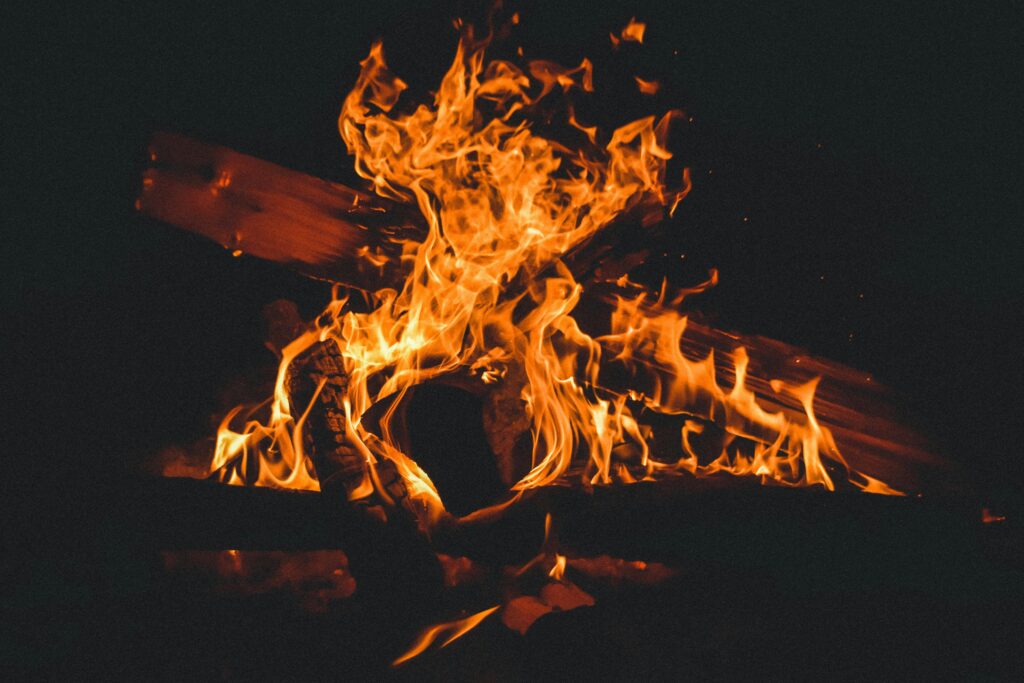If you are considering an outdoor fire pit installation, you are probably confused between the two: gas fire pit and wood fire pit.
While both have their own set of advantages and drawbacks, choosing which outdoor fire pit to install should depend on your lifestyle, budget, and outdoor space.
Green Valley Ranch Landscaping can help you.
In this blog post, we will share and explain the key factors to consider when choosing between gas and wood fire pits so you can make an informed decision that suits your needs.
The Appeal of an Outdoor Fire Pit

Before diving into the comparison, let’s explore why fire pits are such a popular outdoor feature. Below are a few key characteristics that many homeowners love about outdoor fire pits:
- Enhances Outdoor Living. A fire pit extends the usability of your outdoor space, making it cozy and inviting year-round.
- Adds Property Value. A well-installed fire pit can increase your home’s appeal and even boost resale value.
- Great for Socializing. Whether hosting friends or enjoying a quiet night with family, fire pits create the perfect ambiance.
- Versatile Design Options. Fire pits come in various styles, materials, and sizes, allowing customization to fit your backyard aesthetic.
Gas Fire Pits: A Clean and Convenient Option
Pros of Gas Fire Pits
Instant Ignition & Ease of Use
Gas fire pits offer the convenience of instant flames at the touch of a button or flip of a switch. Forget the hassle of stacking wood, lighting matches, and tending kindling.
Minimal Smoke & Clean Burning
Because gas fire pits burn cleanly, they produce no smoke, embers, or lingering odors on clothing or furniture. This clean-burning nature makes them a perfect choice for smaller yards or patios where smoke can be problematic.
Low Maintenance
Gas fire pits eliminate the messy cleanup associated with wood-burning models. There’s no ash, soot, or charred wood to deal with, and once the gas is off, you’re finished – no waiting for embers to die down.
More Control & Customization
With gas fire pits, adjusting the flame and heat is simple, giving you greater control over your fire. Their sleek design also allows for seamless integration into outdoor kitchens or built-in patio features, creating a modern aesthetic.
Safe for Fire-Restricted Areas
During seasonal fire bans, which often restrict wood fires due to wildfire risks, gas fire pits are frequently allowed. This is because they produce neither sparks nor embers, minimizing the risk of igniting surrounding vegetation.
Cons of Gas Fire Pits
Higher Upfront Cost
The need for a propane tank or a direct gas line can increase the initial cost of a gas fire pit. Connecting to a home’s natural gas line, in particular, requires professional installation, which adds significantly to the overall expense.
Less Heat Output
Gas fire pits, while offering ambiance, may not provide the same level of warmth as wood-burning fires, especially on colder nights, due to the lower burning temperature of gas. Additionally, they lack the crackling sounds and rustic aroma associated with traditional wood fires.
Wood-Burning Fire Pit: A Traditional & Rustic Option
Pros of Wood Fire Pits
Authentic Experience
The allure of a genuine wood fire is undeniable. Its crackling sounds, smoky scent, and mesmerizing flames offer a primal and deeply satisfying outdoor experience unlike any other.
Higher Heat Output
For those living in cooler climates or who enjoy cozy evenings outdoors, wood-burning fire pits offer superior warmth compared to their gas counterparts.
Lower Initial Cost
The installation of a basic, freestanding wood fire pit is typically less expensive than a gas fire pit, primarily because it doesn’t involve the cost of gas lines or propane tanks.
Flexibility in Location
Wood-burning fire pits offer greater flexibility in placement since they are not constrained by gas line locations. They can be situated almost anywhere in your yard, provided they comply with local fire regulations.
Cons of Wood Fire Pits
More Maintenance & Cleanup
Maintaining a wood-burning fire pit involves regular cleanup of ash, soot, embers, and leftover wood debris.
Harder to Start & Control
Starting a wood fire requires effort, including gathering dry firewood and kindling, and some patience. Unlike a gas fire, it can’t be extinguished instantly.
Smoke & Air Quality Issues
Wood fires produce smoke, sparks, and strong odors that can be disruptive. Shifting winds can easily carry smoke into seating areas, creating an unpleasant experience for those nearby.
Fire Safety & Restrictions
Due to fire risks, many areas implement seasonal bans on open wood fires. It’s crucial to check local regulations before installing any wood-burning fire pit.
Gas vs. Wood Fire Pits: A Side-by-Side Comparison
For a quick comparison, here’s how wood fire pits and gas fire pits differ from each other.
| Feature | Gas Fire Pit | Wood Fire Pit |
| Ease of Use | Instant ignition | Requires manual lighting |
| Heat Output | Moderate | High |
| Maintenance | Minimal, no ash | Requires ash and soot cleanup |
| Authenticity | Lacks cracking sound and wood scent | Classic campfire feel |
| Cost | Higher upfront, low maintenance | Lower upfront, high ongoing cost |
| Smoke and Odor | None | Strong scent and smoke |
| Regulations | Often permitted even in fire-restricted areas | May be restricted during fire bans |
Final Thoughts
No matter which type of outdoor fire pit you choose, it will undoubtedly enhance your outdoor space and create unforgettable moments for you and your family. If you’re unsure which option best suits your needs, consider consulting with a professional landscaping company to help with design, placement, and installation.
Ready to install your dream fire pit?
Green Valley Ranch Landscaping is here to help you. We offer outdoor landscaping services, including outdoor fire pit installation. Our team guarantees exceptional workmanship that lasts.
Contact us today (720) 572-1532 or send us a message.

